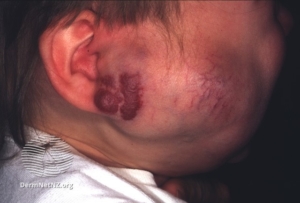Infantile Hemangiomas
Infantile hemangiomas are the most common vascular tumor in infants and children. The majority of hemangiomas are not evident at birth but most become apparent in the first few months of life. Infantile hemangiomas may occur anywhere in the skin, mucous membranes and even internal organs. However, they are usually seen in the head and neck area.
Hemangiomas may range in size from a few millimeters to huge sizes covering a large area of the skin. Hemangiomas may be categorized as focal, segmental, or multiple, depending on the pattern of skin or organ involvement. Most hemangiomas undergo a proliferative phase of accelerated growth, usually during the first few months after diagnosis. Depending on the type of hemangioma, the proliferative phase may or may not be followed by a phase of involution, in which the tumor regresses in size and may even disappear completely.
The diagnosis of hemangiomas is clinical and requires no investigations. Most cutaneous hemangiomas are asymptomatic and require no treatment. However, hemangiomas may lead to ulceration, bleeding, functional impairment, and disfigurement.
Management of hemangiomas differs by case and should be individualized. Options for management may include active observation, medical therapy such as propranolol and corticosteroids, surgery especially if the hemangioma is causing functional impairment and laser therapy.
Written by: Turki Alsehli, Medical Student


Leave a Reply
Want to join the discussion?Feel free to contribute!